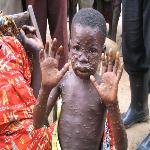13 September 2010

Photo: Dr. Robert Shongo, DRC Ministry of Health/UCLA DRC Monkeypox Project
This 7-year-old Congolese child developed monkeypox after hunting squirrels in the forest surrounding her village.
The eradication of smallpox is linked to an emerging related disease in the Democratic Republic of Congo. Scientists say the appearance of monkeypox could be a cause for concern.
Monkeypox causes symptoms a lot like smallpox, but it's not nearly as fatal. The two viruses are so closely related that the only way to tell them apart is under a microscope. They're so similar that researchers didn't even know they were separate diseases until vaccination eliminated smallpox from African populations.
"Monkeypox probably existed out there for a really long time and it was just counted as a case of smallpox," says UCLA epidemiologist Anne Rimoin.
Rimoin has spent years studying infectious disease in African countries. She explains that monkeypox is a misnomer. The virus is actually carried by rodents which pass the disease along to humans.
"We believe exposure to these animals - whether it be playing with them, hunting them, butchering them, cooking them, any kind of very close interaction with these animals - could result in an infection," Rimoin says.
Rimoin says one of the biggest causes of exposure to monkeypox-carrying animals was when people ate bush meat, wild animals they had hunted.
When smallpox was being eliminated in the 1960s through the 1980s, scientists working in what was then called Zaire (now the Democratic Republic of Congo) first noticed monkeypox. They noticed that people vaccinated against smallpox also got protection against monkeypox and realized that ending smallpox vaccination would allow this related disease to emerge more strongly.
Scientists from Zaire and other countries studied monkeypox, to get an idea of how serious it was, and whether monkeypox transmission could be sustained, passing from human to human, rather than from animal to human.
At the time, the DRC was a very different place. It was more prosperous, with a functioning health care system. And researchers believed the market for bush meat would diminish as people moved into cities.
"With improved social and economic development, the opportunity for monkeypox to cross over into humans would become less and less because humans were going to be less and less dependent upon these animals for protein," Rimoin says.
But the political situation in Congo deteriorated into a decade-long civil war. The economy collapsed, and with it, the health care infrastructure. More people turned to bush meat for food, increasing their contact with animals harboring the monkeypox virus.
It's in this context that Rimoin and an international team recently studied the incidence of the disease.
"Our study indicated a major increase that was never anticipated from the projections of the 1980s," Rimoin says. "We found a twenty-fold rise in the incidence of monkeypox since the cessation of the smallpox vaccination program. We know that the vaccination provided protection against monkeypox and other similar viruses, so the irony is that our victory over smallpox allowed this new disease to flourish."
Rimoin says health officials need to watch monkeypox in Congo, to see if it's becoming more virulent, and to see if it's passing from human to human, not just from animal to human. And she says there's an urgent need to develop strategies to contain the spread of the disease.
Anne Rimoin's paper is published in the Proceedings of the National Academy of Sciences.